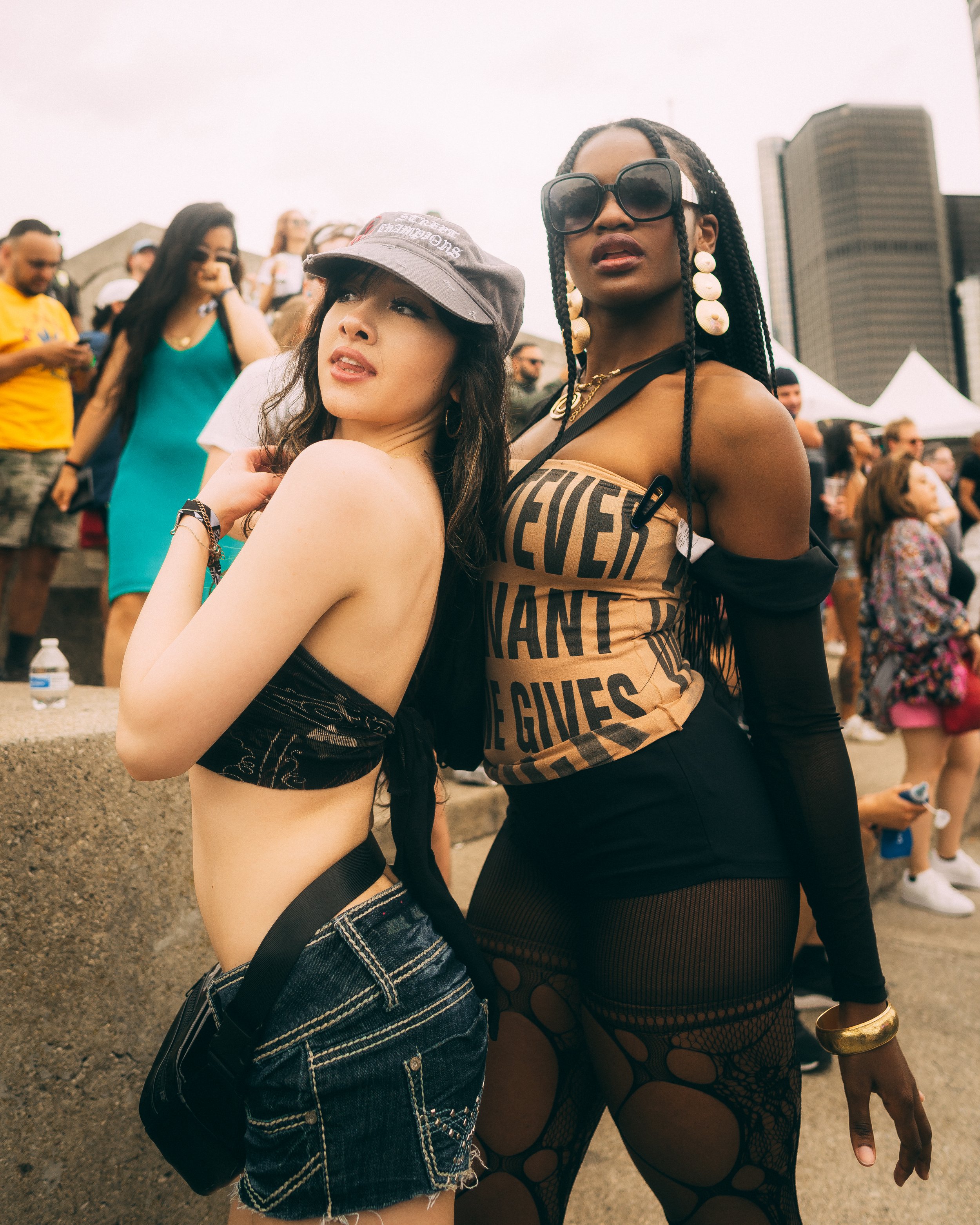Land of the Freaks, Home of the Rave: Movement Festival 2024
Here’s what you missed at the techno-filled festival.
Techno reigned over its homeland — and so did the literal rain. But the spirits of the music lovers remained undampened. Tens of thousands packed into Detroit’s Hart Plaza for Movement Festival, braving the strong winds and downpours (causing a saddening yet necessary evacuation on Sunday). Over 30 daily artists and DJ sets kept people on their three-day benders throughout Memorial Day weekend. We’re not exaggerating. From morning pre-parties to 24-hour after-parties around the city, it gave two-hour night slumbers. But the Detroit People Mover is more than a form of the city’s transportation: It’s the power of its music and the Black techno pioneers who preserve the ever-changing sound.
For the first time in over a decade, the Hart Plaza fountain poured down all weekend — almost as much as Sunday’s rainfall. Colorful lights radiated off the fountain, resembling a descending UFO in the heart of Movement and giving people a nice cool-down as they walked by. That had to be a sight to see for those tripping. Artist Freddy Diaz created a mural and spray-painted low-rider car installation, Drive-In, displayed in the Pyramid Amphitheatre. People waited in line to take photos “inside” the cars and in front of the large-scale mural.
The Underground Music Academy, Resident Advisor, and the Detroit Techno Foundation curated the Respect the Architects exhibit. Located in the Underground Amphitheatre, Respect the Architects explores the impact of techno music in the past, present, and future and the community it holds today. Quintessential rave outfits dominated the dance floors, and so did keffiyehs and Palestinian flags in solidarity with the People of Palestine against Israel’s genocide.










Photos by Isaiah Johns
The energy was high on the first day and never went down. Drugs and alcohol were yet to be cracked open, the sun was out, and people needed to release their pent-up energy through the power of dance. Movement had six stages spanning across Hart Plaza along the Detroit River: the Movement Stage, Waterfront Stage, Star Gate Stage, Underground Stage, Pyramid Stage, and the Detroit Stage. Each stage gave us iconic Detroit trailblazers and international acts like DJ Holographic, Carl Craig, Huey Mnemonic, DJ 3000, Tylr, Tee Grizzley, Floorplan, Channel Tres, Ludacris, Dom Dolla, and many more.
On Sunday’s second day, things felt a little more uncertain and up in the air — that being literal storm clouds. The rain began early, but just as many, if not more, people attended the festival. Around 3 p.m., the storm intensified, leading everybody to the Underground stage, where they danced until they were forced to evacuate the festival. The rain never stopped. People waited in bars, hotels, and stores; some even traveled home. We missed some of our favorite performances, like Sheefy McFly, AK, DJ Godfather, and Coco and Breezy, to protect festival attendees, performers, and equipment. However, the techno gods responded to our prayers. The rain stopped just in time for I Hate Models, Richie Hawtin, James Blake, 999999999, Will Clarke, Kevin Saunderson, and Idris Elba to perform. Gates re-opened at 10 p.m., and goers returned ten-fold like the storm never happened.
On Monday’s third and final day, most of our energy was nearing an end as the last sprint of the three-day bender really started to kick in. However, the festival was far from winding down. It was cool and cloudy, perfect weather to get that last bit of dancing out of their system. Performances and live sets from John Collins, DJ Cent, DJ Tennis, DJ Minx, Honey Dijon, Indira Paganotto, Chris Lake, Goldie, Fatboy Slim, Seth Troxler, and more blessed the stages one last time for the year. The last day of Movement always feels bittersweet, knowing you probably won’t dance that hard again for an entire year.








Photos by Anthony Rassam
Techno was born in Belleville, Michigan, a nearby Detroit suburb, in the 1980s by Kevin Saunderson, Juan Atkins, and Derrick May. At the time, they were known as the Belleville Three at Belleville High School. A new genre came to life with the help of Blake Baxter, Eddie Fowlkes, and James Pennington. Although techno is ever-evolving, the city natives have preserved it with Ghettotech, a genre that blends Detroit and Chicago techno, house, electronic, and Miami bass.
Movement Festival began in 2000 as the Detroit Electronic Music Festival (DEMF) when Carl Craig and Pop Culture Media’s Carol Marvin organized the first three-day Memorial Day weekend techno music festival. In 2001 and 2002, the Ford Motor Company sponsored the festival, briefly renaming it to the Focus Detroit Electronic Music Festival. In 2003, Derrick May took over and renamed it Movement. In 2005, Kevin Saunderson took May’s place and renamed it to Fuse-In. A year later, Saunderson stepped down, and Detroit-based promotion company Paxahau changed it back to Movement, and they have been producing it ever since.
To stay informed about Movement’s 2024 recaps and updates on their 2025 lineup and schedule, you can follow them on Instagram and visit their website.

